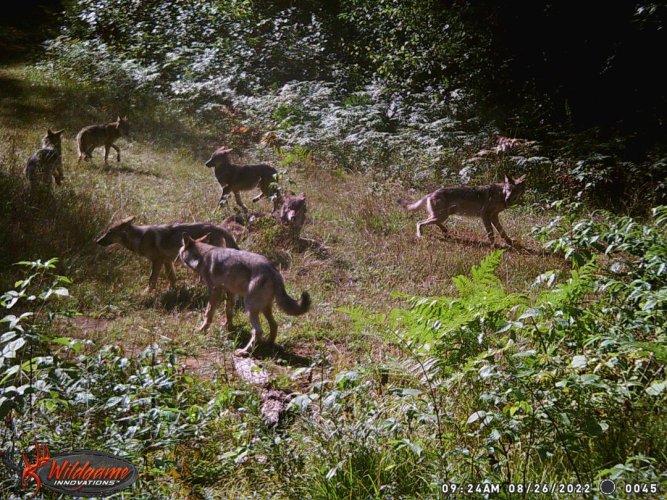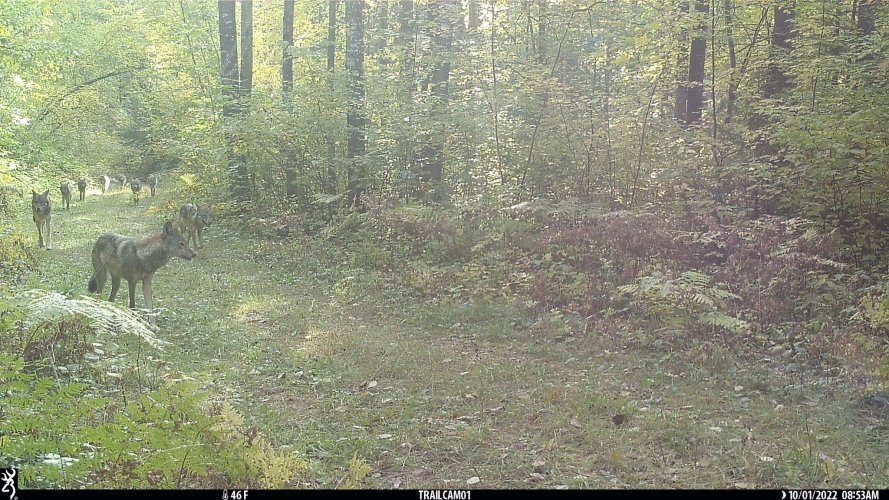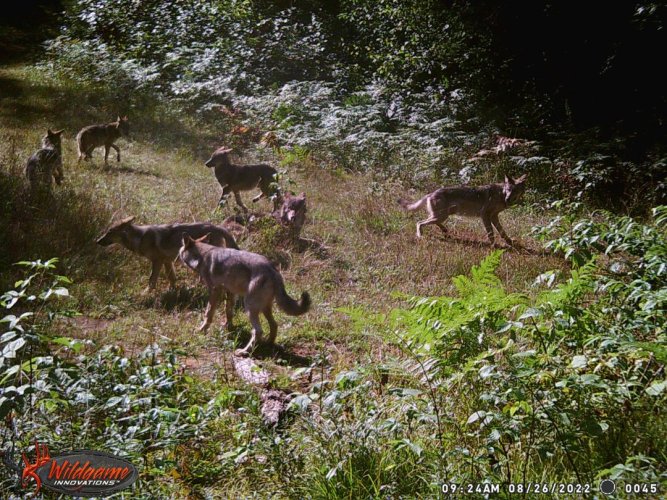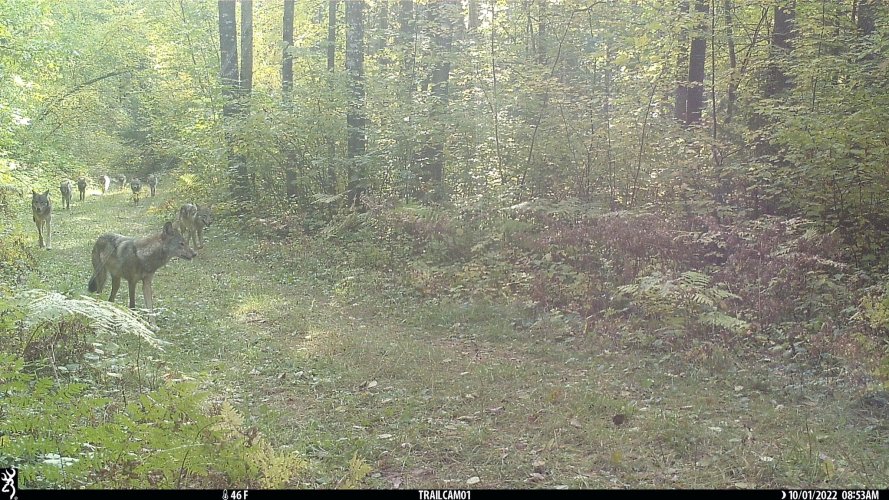cheeser
Well-known member
taken from the https://www.facebook.com/VoyageursWolfProject

 www.voyageurswolfproject.org
www.voyageurswolfproject.org
One of the clearest ways humans have altered wolf predation on fawns is through the creation and maintenance of a dense web of roads, trails, and other linear features that sprawl across the landscape (just check out the maps here).
Linear features provide ideal travel corridors for wolves and allow wolves to cover more ground and do so faster. Indeed, one study determined wolves generally travel 2-3 times faster on human-created linear features than through the woods.
To put that in human terms: that would be like driving 120-180 miles per hour in an area you used to only be able to drive 60 mph.
Naturally, linear features likely increase wolves' ability to find vulnerable prey because of the increase in travel/hunting efficiency and because wolves can cover more ground in a set period of time.
Thus, it is not surprising that wolves showed a strong preference for hunting fawns along/near linear features in our area. You can see this extremely clearly in the maps below. It is also not surprising that wolves disproportionately killed deer fawns near these features either.
Folks often have this misconception that northern Minnesota is a remote, impenetrable wilderness. And while that is true in some areas, much of northern Minnesota (and many other areas outside of Minnesota) have extensive networks of linear features, even in pretty remote areas. Just look at the satellite imagery.
The majority of linear features in our area were initially logging roads created for extracting timber. Many of these roads/trails would naturally get filled in with downed trees, growing vegetation, etc. after logging was completed if the area was left untouched.
However, recreational use—largely by grouse and deer hunters in fall—keeps many of these roads/trails cleared so that folks can access remote areas with ATVs/UTVs, and so the linear features never fill in.
And then there are of course myriad other linear features on the landscape such as power lines, railroad tracks, snowmobile trails, ATV trails made by folks, cleared hunting lanes, etc.
In total, the creation and maintenance of these linear features clearly shapes where wolves hunt and kill fawns. And it is possible that the abundance of linear features actually increases wolf predation on fawns.
This could happen in one of two ways:
The first way that linear features might allow wolves to kill more fawns is simply by making wolves more efficient predators than they would otherwise be. Not hard to see why this might be the case.
A simple analogy would be people foraging for mushrooms (or some other wild edible): imagine there are two people in the same area trying to collect as many mushrooms as they can in a day but one person moves 200-300% faster than the other. There would be little doubt, all else being equal, that the person moving faster is going to find more mushrooms by the end of the day.
The second way this could happen is via changes in wolf territories and densities.
Research out of Montana and northwestern Canada found as the density of linear features increased, wolf territory size decreased. The suspected reason: as linear features become more abundant, wolves can find prey more efficiently and thus they do not need to have as large of a territory to get the same amount of food.
And when territory size decreases, wolf density generally increases because you can now fit more wolves in an area. And higher wolf densities likely mean increased levels of predation.
There has been considerable work done in Canada that has examined and documented how the abundance of linear features has facilitated wolf predation behavior and had a negative impact on caribou.
To ameliorate the unintended effects of linear features, there are active efforts to remediate and restore linear features back to a natural habitat in an effort slow wolves down.
Surprisingly, there has been relatively little work done to examine how the abundance of linear features influences not only wolf-fawn interactions but wolf-deer interactions as a whole.
We published a study earlier this year documenting how wolves actively hunt and kill adult deer throughout the year on human-created linear features but much more work is really needed to flesh this all out. Something we are hoping to continue exploring in the future.
Sources used in this post:
Dickie et al. 2022. Resource exploitation efficiency collapses the home range of an apex predators. Ecology.
Dickie et al. 2017. Faster and farther: wolf movement on linear features and implications for hunting behavior. Journal of Applied Ecology.
Gable et al. 2023. Video observations of wolves hunting ungulates on linear features. Food Webs.
Sells et al. 2021. Evidence of economical territory selection in a cooperative carnivore. Proceedings of the Royal Society B.
Serrouya et al. 2020. Predicting the effects of restoring linear features on woodland caribou populations. Ecological Modeling.

Voyageurs Wolf Project | Studying Wolves During Summer | Minnesota
The official website of the Voyageurs Wolf Project, which is a wolf research project that studies wolves in and around Voyageurs National Park, Minnesota.
 www.voyageurswolfproject.org
www.voyageurswolfproject.org
One of the clearest ways humans have altered wolf predation on fawns is through the creation and maintenance of a dense web of roads, trails, and other linear features that sprawl across the landscape (just check out the maps here).
Linear features provide ideal travel corridors for wolves and allow wolves to cover more ground and do so faster. Indeed, one study determined wolves generally travel 2-3 times faster on human-created linear features than through the woods.
To put that in human terms: that would be like driving 120-180 miles per hour in an area you used to only be able to drive 60 mph.
Naturally, linear features likely increase wolves' ability to find vulnerable prey because of the increase in travel/hunting efficiency and because wolves can cover more ground in a set period of time.
Thus, it is not surprising that wolves showed a strong preference for hunting fawns along/near linear features in our area. You can see this extremely clearly in the maps below. It is also not surprising that wolves disproportionately killed deer fawns near these features either.
Folks often have this misconception that northern Minnesota is a remote, impenetrable wilderness. And while that is true in some areas, much of northern Minnesota (and many other areas outside of Minnesota) have extensive networks of linear features, even in pretty remote areas. Just look at the satellite imagery.
The majority of linear features in our area were initially logging roads created for extracting timber. Many of these roads/trails would naturally get filled in with downed trees, growing vegetation, etc. after logging was completed if the area was left untouched.
However, recreational use—largely by grouse and deer hunters in fall—keeps many of these roads/trails cleared so that folks can access remote areas with ATVs/UTVs, and so the linear features never fill in.
And then there are of course myriad other linear features on the landscape such as power lines, railroad tracks, snowmobile trails, ATV trails made by folks, cleared hunting lanes, etc.
In total, the creation and maintenance of these linear features clearly shapes where wolves hunt and kill fawns. And it is possible that the abundance of linear features actually increases wolf predation on fawns.
This could happen in one of two ways:
The first way that linear features might allow wolves to kill more fawns is simply by making wolves more efficient predators than they would otherwise be. Not hard to see why this might be the case.
A simple analogy would be people foraging for mushrooms (or some other wild edible): imagine there are two people in the same area trying to collect as many mushrooms as they can in a day but one person moves 200-300% faster than the other. There would be little doubt, all else being equal, that the person moving faster is going to find more mushrooms by the end of the day.
The second way this could happen is via changes in wolf territories and densities.
Research out of Montana and northwestern Canada found as the density of linear features increased, wolf territory size decreased. The suspected reason: as linear features become more abundant, wolves can find prey more efficiently and thus they do not need to have as large of a territory to get the same amount of food.
And when territory size decreases, wolf density generally increases because you can now fit more wolves in an area. And higher wolf densities likely mean increased levels of predation.
There has been considerable work done in Canada that has examined and documented how the abundance of linear features has facilitated wolf predation behavior and had a negative impact on caribou.
To ameliorate the unintended effects of linear features, there are active efforts to remediate and restore linear features back to a natural habitat in an effort slow wolves down.
Surprisingly, there has been relatively little work done to examine how the abundance of linear features influences not only wolf-fawn interactions but wolf-deer interactions as a whole.
We published a study earlier this year documenting how wolves actively hunt and kill adult deer throughout the year on human-created linear features but much more work is really needed to flesh this all out. Something we are hoping to continue exploring in the future.
Sources used in this post:
Dickie et al. 2022. Resource exploitation efficiency collapses the home range of an apex predators. Ecology.
Dickie et al. 2017. Faster and farther: wolf movement on linear features and implications for hunting behavior. Journal of Applied Ecology.
Gable et al. 2023. Video observations of wolves hunting ungulates on linear features. Food Webs.
Sells et al. 2021. Evidence of economical territory selection in a cooperative carnivore. Proceedings of the Royal Society B.
Serrouya et al. 2020. Predicting the effects of restoring linear features on woodland caribou populations. Ecological Modeling.








